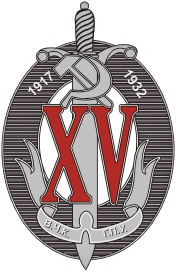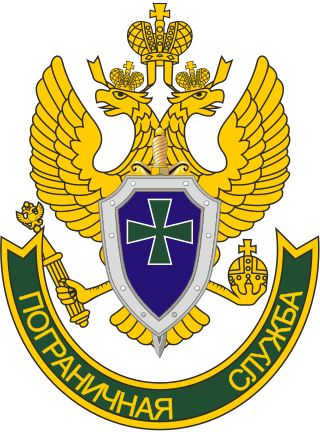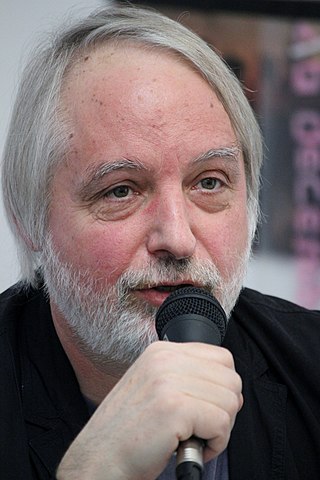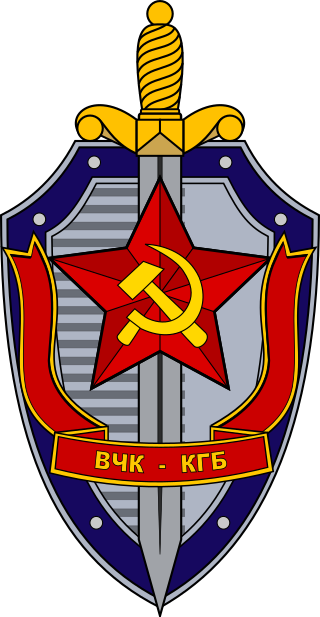A sharashka, formally called Russian: особое конструкторское бюро, ОКБ and similar terms, were secret research and development laboratories operating from 1930 to the 1950s within the Soviet Gulag labor camp system, as well as in other facilies under the supervision of the Soviet secret service. Etymologically, the word sharashka derives from a Russian slang expression sharashkina kontora,, which in its turn comes from the criminal argot term sharaga (шарага) for a band of thieves, hoodlums, etc.) an ironic, derogatory term to denote a poorly-organized, impromptu, or bluffing organization.

SMERSH was an umbrella organization for three independent counter-intelligence agencies in the Red Army formed in late 1942 or even earlier, but officially announced only on 14 April 1943. The name SMERSH was coined by Joseph Stalin. The formal justification for its creation was to subvert the attempts by Nazi German forces to infiltrate the Red Army on the Eastern Front.

The State Political Directorate (GPU) was the intelligence service and secret police of the Russian Soviet Federative Socialist Republic (RSFSR) from February 6, 1922, to December 29, 1922, and the Soviet Union from December 29, 1922, until November 15, 1923.

Viktor Semyonovich Abakumov was a high-level Soviet security official from 1943 to 1946, the head of SMERSH in the USSR People's Commissariat of Defense, and from 1946 to 1951 Minister of State Security or MGB (ex-NKGB). He was removed from office and arrested in 1951 on fabricated charges of failing to investigate the Doctors' Plot. After the death of Joseph Stalin, Abakumov was tried for fabricating the Leningrad Affair, sentenced to death and executed in 1954.

The First Main Directorateof the Committee for State Security under the USSR council of ministers was the organization responsible for foreign operations and intelligence activities by providing for the training and management of covert agents, intelligence collection administration, and the acquisition of foreign and domestic political, scientific and technical intelligence for the Soviet Union. The First Chief Directorate was formed within the KGB directorate in 1954, and after the collapse of the Soviet Union became the Foreign Intelligence Service. The primary foreign intelligence service in Russia and the Soviet Union has been the GRU, a military intelligence organization and special operations force.
There were a succession of Soviet secret police agencies over time. The first secret police after the October Revolution, created by Vladimir Lenin's decree on December 20, 1917, was called "Cheka" (ЧК). Officers were referred to as "chekists", a name that is still informally applied to people under the Federal Security Service of Russia, the KGB's successor in Russia after the dissolution of the Soviet Union.
The Main Directorate of State Security was the name of the Soviet most important security body within the People's Commissariat of Internal Affairs (NKVD) USSR. At the time of its existence, which was from July 10, 1934 to February 3, 1941, the GUGB reflected exactly the Secret Operational Directorate within OGPU under Council of People's Commissars, which operated within OGPU structure from 1923 to 1931/32. An intelligence service and secret police from July 1934 to February 1941, it was run under the auspices of the Peoples Commissariat of Internal Affairs (NKVD). Its first head was first deputy of People's Commissar of Internal Affairs, Commissioner 1st rank of State Security Yakov Agranov.

Main Directorate for the Protection of State Secrets in the Press under the Council of Ministers of the USSR was the official censorship and state secret protection organ in the Soviet Union. The censorship agency was established in 1922 under the name "Main Administration for Literary and Publishing Affairs at the RSFSR Narkompros", abbreviated as Glavlit (Главлит). The latter term was in semiofficial use until the dissolution of the Soviet Union.

The Border Service of the Federal Security Service of the Russian Federation is a branch of Federal Security Service of Russia tasked with patrol of the Russian border.

Nikita Vasilyevich Petrov is a Russian historian. He works at Memorial, a Russian organization dedicated to studying Soviet political repression. Petrov specializes in Soviet security services.

The Committee for State Security (CSS) was the main security agency for the Soviet Union from 13 March 1954 until 3 December 1991. As a direct successor of preceding agencies such as the Cheka, GPU, OGPU, NKGB, NKVD and MGB, it was attached to the Council of Ministers. It was the chief government agency of "union-republican jurisdiction", carrying out internal security, foreign intelligence, counter-intelligence and secret police functions. Similar agencies operated in each of the republics of the Soviet Union aside from the Russian SFSR, where the KGB was headquartered, with many associated ministries, state committees and state commissions.

Vsevolod Apollonovych Balytsky was a Soviet official, Commissar of State Security 1st Class of the NKVD and a member of the Central Committee of the Communist Party of the Soviet Union.
The Joint State Political Directorate (JSPD) (OGPU; Russian: Объединённое государственное политическое управление) was the intelligence and state security service and secret police of the Soviet Union from 1923 to 1934.
The People's Commissariat for State Security or NKGB, was the name of the Soviet secret police, intelligence and counter-intelligence force that existed from 3 February 1941 to 20 July 1941, and again in 1943, before being renamed the Ministry for State Security (MGB).

The People's Commissariat for Internal Affairs (PCIA) (Russian: Наро́дный комиссариа́т вну́тренних дел, romanized: Narodný komissariat vnutrennih del (NKVD), pronounced [nɐˈrod.nɨj kə.mʲɪ.sə.rʲɪˈat ˈvnut.rʲɪ.nʲɪx̬ dʲel]), abbreviated NKVD (НКВД ), was the interior ministry of the Soviet Union.

Main Intelligence Directorate, abbreviated GRU, was the foreign military intelligence agency of the Soviet Army General Staff of the Soviet Union until 1991. For a few months it was also the foreign military intelligence agency of the newly established Russian Federation until 7 May 1992 when it was dissolved and the Russian GRU took over its activities.
Pavlo Yakovlevich Meshyk was a Ukrainian Soviet security operative and NKVD officer.
Ivan Lavrentevich Ustinov was a Soviet intelligence officer who held a number of posts in Soviet military counterintelligence, reaching the rank of general-lieutenant.
Pyotr Ivanovich Ivashutin was a Soviet Army General and head of the state and military security organs, who was deputy chairman of the KGB (1954-1963), temporary acting head of the KGB in 1961 and the longest running head of the GRU.
Directorate of Special Departments within NKVD USSR. rus. Управление Особых Отделов при НКВД СССР, (UOO) was an organization created in 1941 to conduct military counterintelligence under one command. The UOO was created to take back control from the retreating Red Army after the German invasion of the USSR and to counter German espionage efforts in the Soviet Armed forces. The principle tactic used by the UOO on Red Army personnel was intimidation and terror.











